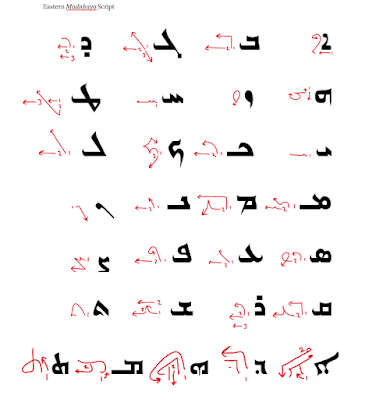Writing Out the Letters
Syriac has twenty-two letters. Esṭrāngellā is the oldest
style of writing, although all three scripts belong to all Syriac traditions.
Syriac manuscripts demonstrate varied mix of styles that scripts today
considered mutually exclusive were originally found across a broad continuum.
Western (Sertā) often
appear from the pen of a very Madnḥaya writer and visa-versa.
Nevertheless, the advent of the printing press has seen the scripts become
consistently segregated by church tradition. Sertā style is used by the Syriac Orthodox and Madnḥaya is used by the members of the
Church of the East, or ‘Easterners.’ Serṭā itself means to scratch, to
draw, or to write, but here it likely refers to a script developed first for
the beeswax covered writing tablet, which likely gives the style its pointed
and elegant style. Among Easterners, it is also called rhatā, or
running script due to its quick form. Under the name of rhatā, it was
considered an Eastern Script, although today few know of this tradition. A
well-formed Syriac writer will know all three scripts with little difficulty.
The reed dip pen is the traditional writing instrument. Before the advent of paper, parchment was used, which was expensive. Writing of a less permanent nature would be done on a wooden board that had a raised frame with beeswax so that writing could be carved into it with a sharp stylus. Permanent writing, and eventually all writing as paper became an affordable and, later, disposable medium, was achieved with a cut reed and either India Ink or Iron-Gall ink. Eastern Script’s more broad and bold style requires several strokes and consumes more ink per letter than Western Script, which is written with a more narrow cut to the reed. Western Script more often draws a letter left to right whereas Eastern from right to left, assuming the scribe is writing with the page at a 90-degree counter-clockwise rotation. Given the western habit of writing on a desk, with paper roughly perpendicular to the edge of the desk, this translates to Western more often forming letters from the top down, versus the bottom up tendency of the Eastern scribe. Middle Eastern scribes traditionally sit on a floor mat, using their thigh as a writing surface and thus forming lines of script almost perpendicular to their waist. Small desks or lap boards are also used while seated.
Paper is often lined, using a board with strings tied to form a stencil. Lines are pressed, with a cloth over the right thumb by orienting the paper over the board, then pressing paper on the strings. TRT World has a beautiful video depicting Syriac calligraphy here. For any beginner interested in trying a broad tipped pen for Syriac writing, there are modified Pilot fountain pens available that permit proper letter formation as if using a reed pen and ink jar, but with much less technical skills required. Traditionally ink must be kept at the appropriate consistency in a jar with silk thread, and then applied with a reed properly cut, with its tip maintained.Traditionally, the alphabet is taught using a set of five mnemonics:
ʾabgad hawaz ḥaṭi kalman saʿpaṣ qaršaṯ
ܐܲܒܓܲܕ ܗܲܘܲܙ ܚܲܛܝܼ ܟܲܠܡܲܢ ܣܲܥܦܲܨ ܩܲܪܫܲܬ.
Consonants āṯwāṯā (ܐܵܬܼ̈ܘܵܬܼܵܐ):
Gutteral/gag̱rāyāṯā: ʾ, h, ḥ, ʿ ܓܲܓܼܪܵܝܵܬܼܵܐ: ܐ، ܗ، ܚ، ܥ
Lingual/lešānāyātā: d, ṭ,
l, n, t, r ܠܸܫܵܢܵܝܵܬܵܐ: ܕ.ܛ.ܠ.ܢܢ. ܬ. ܪ
Palatal/ḥekāyātā: g, y, k, q ܚܸܟܵܝܵܬܵܐ: ܓ. ܝ. ܟܟ. ܩ
Dental/šenāyātā: z, s, ṣ, š ܫܸܢܵܝܵܬܵܐ:
ܙ. ܣ . ܨ . ܫ[1]
Labial/sepwātānāyātā: b, w, m, p ܣܸܦܘܵܬܵܢܵܝܵܬܵܐ:
ܒ. ܘ . ܡ. ܦ



